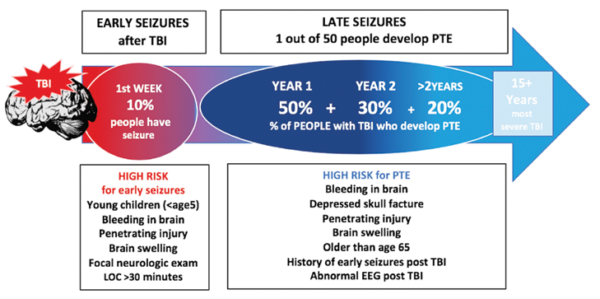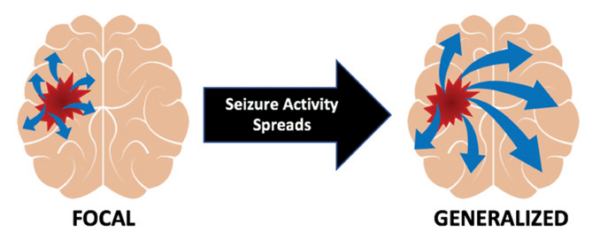Traumatic Brain Injury, Seizures, and Epilepsy
Categories: Living with Brain Injury, Research
By Elaine Kiriakopoulos MD, MSc, Epilepsy Foundation
Traumatic brain injury (TBI) is a well-recognized cause of seizures and epilepsy. Traumatic brain injuries can range from mild, to moderate, to severe, and as a result, the spectrum of impact on any individual can vary. Mild trauma to the brain may affect brain cell function for hours, days, or weeks. More severe brain injuries often have more long-term effects and can result in significant disability or death. A range of both physical cognitive and psychiatric symptoms can be present after a traumatic brain injury. In addition, changes in movement, sensation, vision and hearing are possible and seizures and epilepsy are a relatively frequent complication of TBI.
The area of the brain affected by the injury, the extent of the brain injury, and the age and general health of a person before the injury will determine how a person is impacted.
What do we know about seizures and TBI?
Seizures can occur early (within the first week of the brain injury), or late (more than a week after brain injury). Seizures which occur early after a traumatic brain injury are felt to be a symptom of the recent injury. Seizures which occur in the late period after TBI are more likely to recur and result in epilepsy.

Early seizures in TBI
People who have head injuries that are more serious that cause brain swelling or blood on the outside of the brain, or involve the brain being penetrated by a foreign object, or are accompanied by an extended period with loss of consciousness (>30 minutes) are more likely to have early seizures.
In some cases, even if a head injury is “mild” and a person has no evidence of injury to the brain on brain imaging with CT or MRI, a seizure may still occur.
People with early seizures after a brain trauma are at higher risk for developing post-traumatic epilepsy.
What are late seizures?
Seizures which occur more than a week after a traumatic brain injury are considered late seizures. Most often when this happens, it is because there has been more serious injury to brain cells and the chemical environment around the cells has also changed. Late seizures are more likely to lead to the complication of post-traumatic epilepsy.
Post-Traumatic Epilepsy (PTE)
A person with post-traumatic epilepsy (PTE) is someone with risk for recurrent seizures as a result of a brain injury. About 1 in 50 people who have traumatic brain injuries will go on to develop PTE. There is a spectrum of severity of PTE that ranges from well-controlled seizures to disabling seizures that are resistant to treatment.
What types of seizures do people with post-traumatic epilepsy have?
Most seizures (8 out of 10 people) in post-traumatic epilepsy are focal and may spread to become bilateral tonic clonic seizures. This means that they start in one area of the brain (focal) but spread to involve the entire brain (generalized). Sometimes the beginning of these seizures (focal onset) can be determined and relates to the area of the brain injured, other times it is harder to determine where a seizure begins. A person may have focal aware or focal impaired awareness seizures but these are less frequent (occur in about 2 out of 10 people).
In one out of two people, post traumatic epilepsy occurs within one year of their brain injury. The more severe the head injury the longer a person is at risk for developing epilepsy. Risk for PTE developing decreases substantially with time but can extend out to 15 years after the original traumatic injury for people with the most severe brain injuries.
What changes in the brain can cause seizures after a TBI?
The structural, chemical, and functional changes that result in seizures after TBI are still being studied. It is known that the type of changes that occur in brain tissue after a TBI depend on the type of trauma.
- Closed head injury can result in bleeding in the brain (hemorrhage), bruising of brain (contusions), shearing injury to the white matter tracts in the brain (diffuse axonal injury), brain swelling (edema), and a lack of blood flow to brain tissue (ischemia).
- Chemical changes in the brain which influence how brain cells function are also known to occur after a TBI.
- Penetrating injuries can result in a scar forming in brain tissue, or cause a scar to form that involves the outer layer of the brain (cortex) and its coverings (meninges).
- Electrophysiologic and imaging biomarkers are being studied as potential tools to better understand the brain changes related to seizures after TBI.
- Blood and cerebrospinal fluid (CSF) biomarkers being studied may also make it possible to better understand the changes that occur leading to posttraumatic epilepsy.
How are seizures treated in TBI?
Antiseizure medication (ASM) is first-line therapy used to treat seizures after TBI. Treatment with ASM is typical if a person experiences even a single seizure early after TBI. Early treatment with ASM is started to help lower the likelihood of progression to status epilepticus.
Controlling seizures quickly is important to lower risk for further injury to the brain. The length of treatment (weeks, months) with antiseizure medication is weighed carefully for each individual depending on extent of injury and likelihood for recurrent seizures. In late seizures, there is a high, about 8 out of 10 people, recurrence rate for seizures.
Because of the high rate for repeat seizures, long-term anticonvulsant treatment is recommended for people who have even one late (more than one week after TBI) seizure. The choice of antiseizure medication will be based on the type of seizures a person has, and their individual medical history (co-morbid illness, medication tolerance).
This article originally appeared in Volume 16, Issue 4 of THE Challenge! published in 2022.

